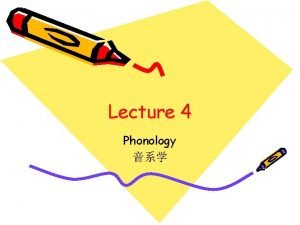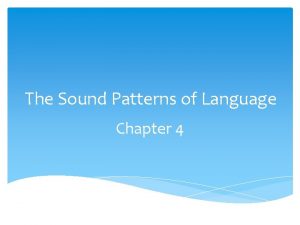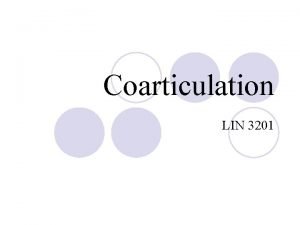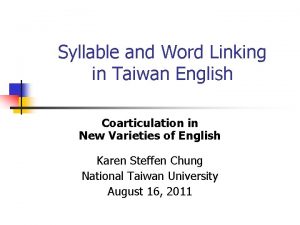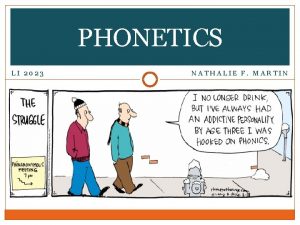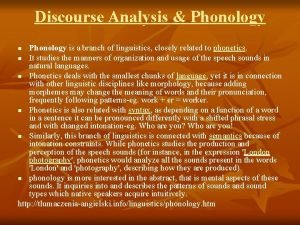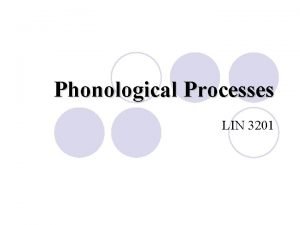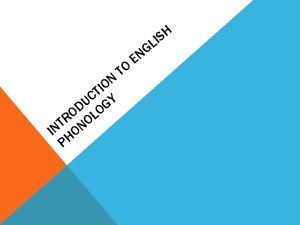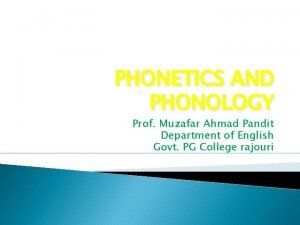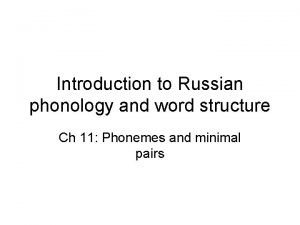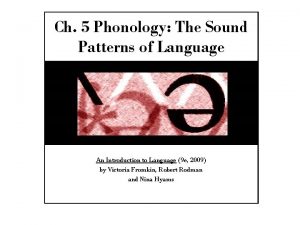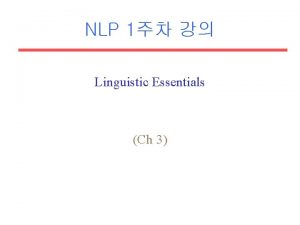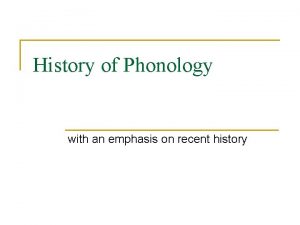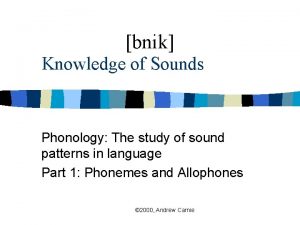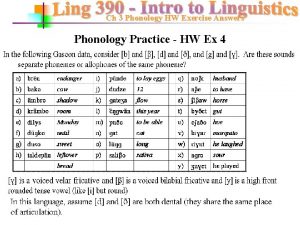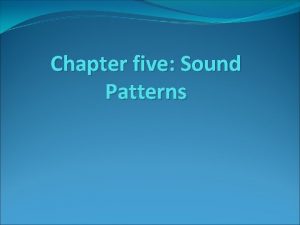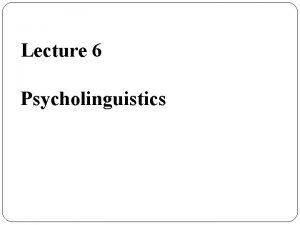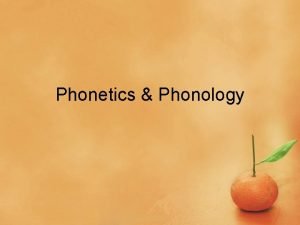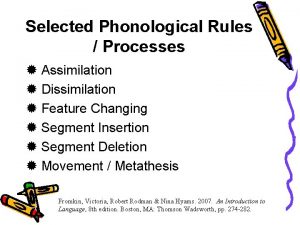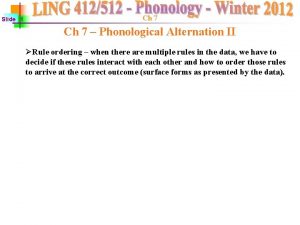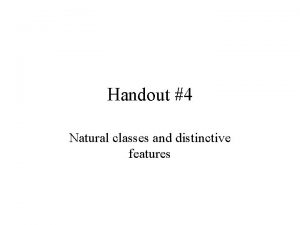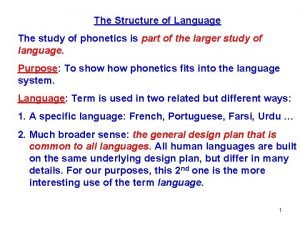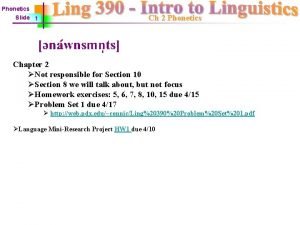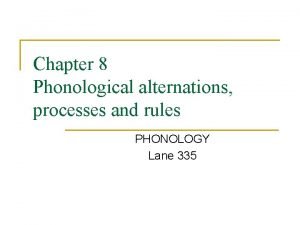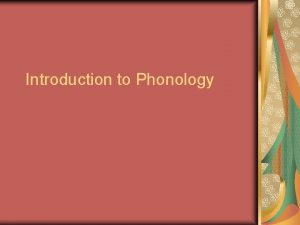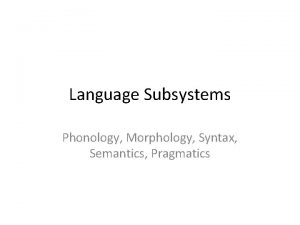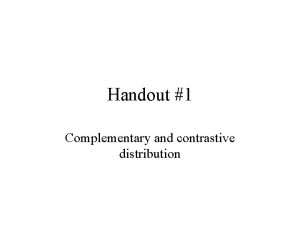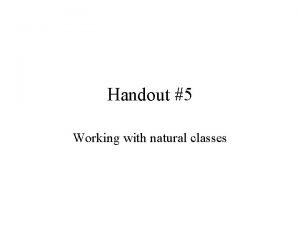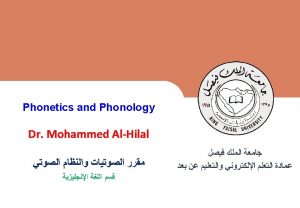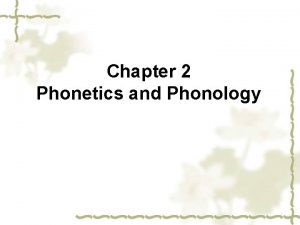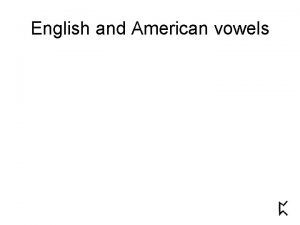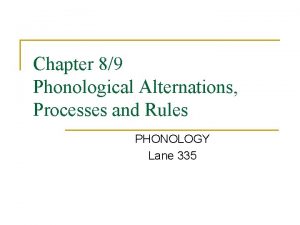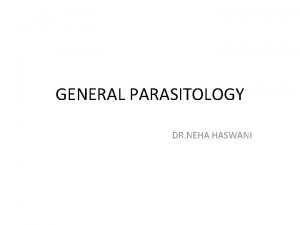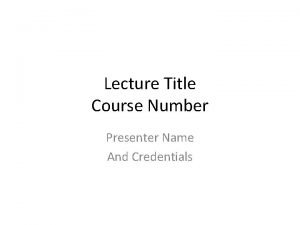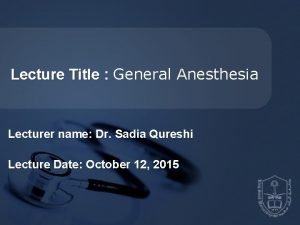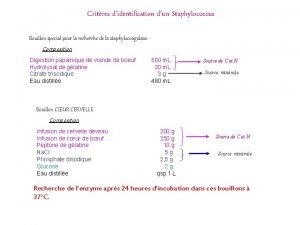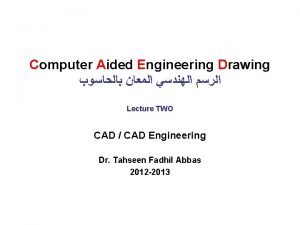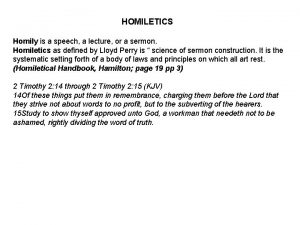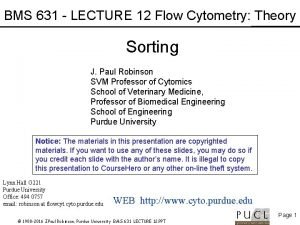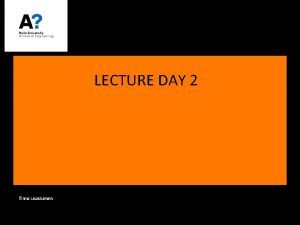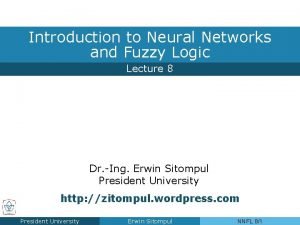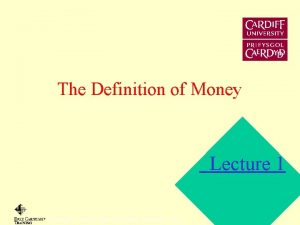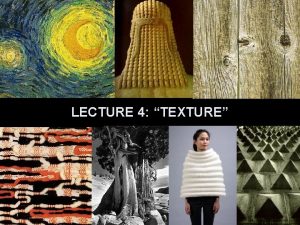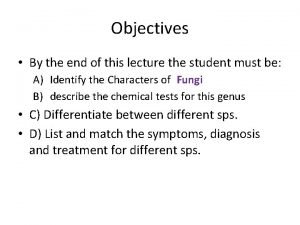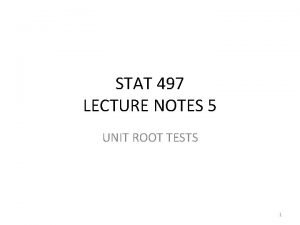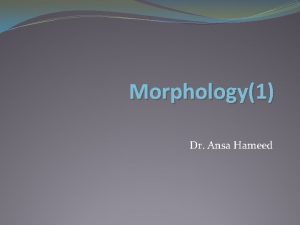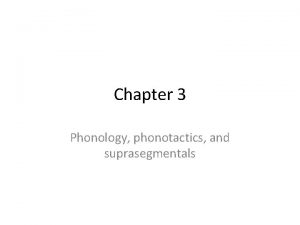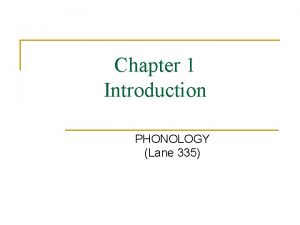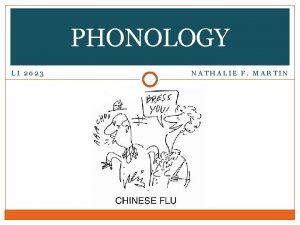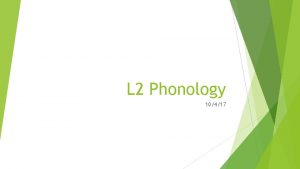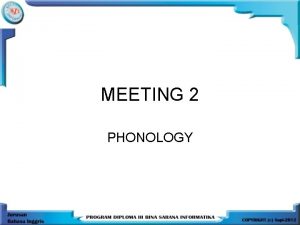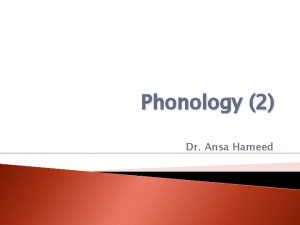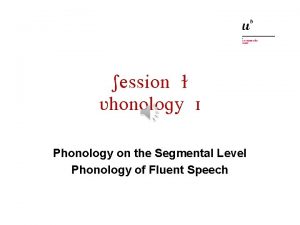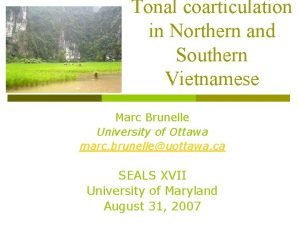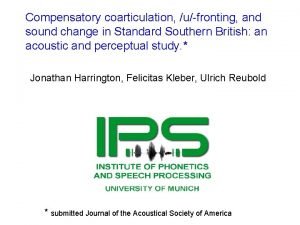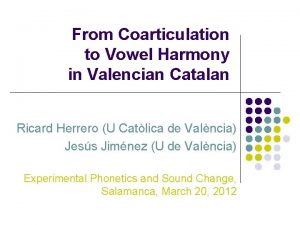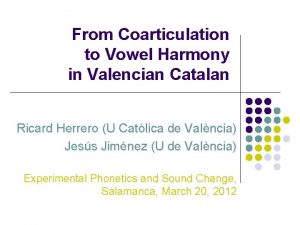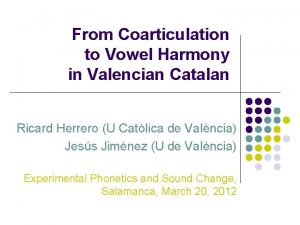Lecture 4 Phonology 4 0 Coarticulation 4 1





![Broad and narrow trans-cription 宽式音标与窄式音标 • Nasalization [~ ]; aspiration [h] • When we Broad and narrow trans-cription 宽式音标与窄式音标 • Nasalization [~ ]; aspiration [h] • When we](https://slidetodoc.com/presentation_image_h/09e75d834dfd3e2db45dcfe243236616/image-6.jpg)








![Different selection of contrastive sounds • English: [p ] and [p] are not different Different selection of contrastive sounds • English: [p ] and [p] are not different](https://slidetodoc.com/presentation_image_h/09e75d834dfd3e2db45dcfe243236616/image-15.jpg)



![• [p, p ] are in complementary contribution. [p] occurs after [s] while • [p, p ] are in complementary contribution. [p] occurs after [s] while](https://slidetodoc.com/presentation_image_h/09e75d834dfd3e2db45dcfe243236616/image-19.jpg)
![• “Dark l” [ ] and “clear l” [l] are in complementary distribution. • “Dark l” [ ] and “clear l” [l] are in complementary distribution.](https://slidetodoc.com/presentation_image_h/09e75d834dfd3e2db45dcfe243236616/image-20.jpg)


![free variation found in regional differences • either [ , ] • direct [ free variation found in regional differences • either [ , ] • direct [](https://slidetodoc.com/presentation_image_h/09e75d834dfd3e2db45dcfe243236616/image-23.jpg)


![Nasalization 鼻音化 • a. cap [kæp] can [kæ n] b. tap [tæp] tan [tæ Nasalization 鼻音化 • a. cap [kæp] can [kæ n] b. tap [tæp] tan [tæ](https://slidetodoc.com/presentation_image_h/09e75d834dfd3e2db45dcfe243236616/image-26.jpg)
![Dentalization 齿音化 • a. tent [tɛnt] tenth [tɛn θ] b. ninety [naɪnti] ninth [naɪn Dentalization 齿音化 • a. tent [tɛnt] tenth [tɛn θ] b. ninety [naɪnti] ninth [naɪn](https://slidetodoc.com/presentation_image_h/09e75d834dfd3e2db45dcfe243236616/image-27.jpg)
![Velarization 腭音化 • a. since [sɪns] sink [sɪŋk] b. mince [mɪns] mink [mɪŋk] Velarization 腭音化 • a. since [sɪns] sink [sɪŋk] b. mince [mɪns] mink [mɪŋk]](https://slidetodoc.com/presentation_image_h/09e75d834dfd3e2db45dcfe243236616/image-28.jpg)
![Assimilation across syllables • a. pan[ŋ]cake pan [p n] • b. sun[ŋ]glasses • sun Assimilation across syllables • a. pan[ŋ]cake pan [p n] • b. sun[ŋ]glasses • sun](https://slidetodoc.com/presentation_image_h/09e75d834dfd3e2db45dcfe243236616/image-29.jpg)


![1) Devoicing rule voiced fricative → voiceless / _____ voiceless 2) Nasalization rule [–nasal] 1) Devoicing rule voiced fricative → voiceless / _____ voiceless 2) Nasalization rule [–nasal]](https://slidetodoc.com/presentation_image_h/09e75d834dfd3e2db45dcfe243236616/image-32.jpg)








![• Some of the major distinctions include [consonantal], [sonorant], [nasal] and [voiced]. The • Some of the major distinctions include [consonantal], [sonorant], [nasal] and [voiced]. The](https://slidetodoc.com/presentation_image_h/09e75d834dfd3e2db45dcfe243236616/image-41.jpg)



![[±spread] for aspiration and unaspiration [±spread] for aspiration and unaspiration](https://slidetodoc.com/presentation_image_h/09e75d834dfd3e2db45dcfe243236616/image-45.jpg)

























- Slides: 70

Lecture 4 Phonology 音系学

• 4. 0 Coarticulation 协同发音 • 4. 1 Phonological analysis 音位分析 • 4. 2 Phonemes and allophones 音位与音位变 体 • 4. 3 Phonological Processes 音位过程 • 4. 4 Distinctive features 区别性特征 • 4. 5 Suprasegmental phonology 超语段音位 学

4. 0 Coarticulation 协同发音 • Coarticulation refers to the variation that a speech sound undergoes under the influence of neighbouring sounds.

Anticipatory coarticulation • If the sound becomes more like the following sound, as in the case of lamb, it is known as anticipatory coarticulation (逆化 协同发音)or right-to-left coarticulation (L < R). Thus in the string …AB…, sound A is influenced by sound B. • lamb

Perseverative coarticulation • If the sound displays the influence of the preceding sound, it is perseverative coarticulation (重复协同发音) or left-toright coarticulation (L > R), as in the case of map. Thus in the string …CD…, sound C influences sound D. • map
![Broad and narrow transcription 宽式音标与窄式音标 Nasalization aspiration h When we Broad and narrow trans-cription 宽式音标与窄式音标 • Nasalization [~ ]; aspiration [h] • When we](https://slidetodoc.com/presentation_image_h/09e75d834dfd3e2db45dcfe243236616/image-6.jpg)
Broad and narrow trans-cription 宽式音标与窄式音标 • Nasalization [~ ]; aspiration [h] • When we use a simple set of symbols in our transcription, it is called broad transcription (宽式音标). And if we use more specific diacritics to show more phonetic detail, it is called narrow transcription (窄式音标). Both are phonetic transcriptions so we put both forms in square brackets [].


4. 1 Phonological analysis • Phonology is the study of sound systems, in order to identify the distinctive sounds in a particular language, and to discover the patterns the sounds fall into. It has two primary aims: 1) to discover the principle governing the organization of sounds; 2) to explain the variations that occur. The technical term for the distinctive sounds is “phoneme” (音位).

Phoneticians vs. phonologists • Phoneticians are concerned with how sounds differ in the way they are pronounced while phonologists are interested in the patterning of such sounds and the rules that underlie such variations. • kite [k t] vs. sky [sk ]

4. 2 Phonemes and allophones • 4. 2. 1 Minimal pairs 最小对立体 • 4. 2. 2 The Phoneme theory 音位理论 • 4. 2. 3 Allophones 音位变体

4. 2. 1 Minimal pairs • Phonological analysis relies on the principle that certain sounds cause change in the meaning of a word, while other sounds do not. A technique to find out which sound substitutions cause differences of meaning is called “minimal pairs” test. That is, we take a word, replace one sound by another, and see whether it results in a different meaning. By this technique we have identified more than 40 phonemes in English. The phonemes are transcribed using the normal set of phonetic symbols, but within slant lines instead of square brackets.



4. 2. 2 The phoneme theory • Phoneme is a term used to denote the smallest sound units that can be segmented from the acoustic flow of speech and which can function as semantically distinctive units.
![Different selection of contrastive sounds English p and p are not different Different selection of contrastive sounds • English: [p ] and [p] are not different](https://slidetodoc.com/presentation_image_h/09e75d834dfd3e2db45dcfe243236616/image-15.jpg)
Different selection of contrastive sounds • English: [p ] and [p] are not different phonemes. • Chinese: [p ] and [p] are different phonemes, as in “波” and “泼”.

4. 2. 3 Allophones • 4. 2. 3. 1 Phonetic transcription and phonemic transcription • 4. 2. 3. 2 Phones and allophones 音素与 音位变体 • 4. 2. 3. 3 Free variants 自由变体

4. 2. 3. 1 Phonetic transcription and phonemic transcription • • Phonemic transcription: peak /pi k/, speak /spi k/ Phonetic transcription: peak [p i k], speak [spi k]

4. 2. 3. 2 Phones and allophones 音素与音位变体 • PHONE - A speech sound considered without reference to its status as a phoneme or an allophone in a language. ALLOPHONE - variants of a same phoneme. COMPLEMENTARY DISTRIBUTION - the mutually exclusive relationship between two phonetically similar segments. It exists when one segment occurs in an environment where the other segment never occurs.
![p p are in complementary contribution p occurs after s while • [p, p ] are in complementary contribution. [p] occurs after [s] while](https://slidetodoc.com/presentation_image_h/09e75d834dfd3e2db45dcfe243236616/image-19.jpg)
• [p, p ] are in complementary contribution. [p] occurs after [s] while [p ] occurs in other places. • /p/ → [p] / [s]_____ • [p ] elsewhere
![Dark l and clear l l are in complementary distribution • “Dark l” [ ] and “clear l” [l] are in complementary distribution.](https://slidetodoc.com/presentation_image_h/09e75d834dfd3e2db45dcfe243236616/image-20.jpg)
• “Dark l” [ ] and “clear l” [l] are in complementary distribution. • /l/ → [l] / ____V • [ ] / V ____

Phonetic similarity • Phonetic similarity means that the allophones of a phoneme must bear some phonetic resemblance. For example, the dark and clear l are both lateral approximants and they only differ in places of articulation; the aspirated and unaspirated /p/ are both voiceless bilabial stops differing only in aspiration. In both cases, the allophones are both phonetically similar and in complementary distribution.

4. 2. 3. 3 Free variants 自 由变体 • Free variation is the interchangeable relationship between two phones , in which the phones may substitute for one another in the same environment without causing a change in meaning. • cup: [k p ] and [k p ]
![free variation found in regional differences either direct free variation found in regional differences • either [ , ] • direct [](https://slidetodoc.com/presentation_image_h/09e75d834dfd3e2db45dcfe243236616/image-23.jpg)
free variation found in regional differences • either [ , ] • direct [ , ]

4. 3 Phonological processes • 4. 3. 1 Assimilation 同化 • 4. 3. 2 Phonological processes and phonological rules 音位过程与音位规则 • 4. 3. 3 Rule ordering

4. 3. 1 Assimilation 同化 • Assimilation refers to the process by which one sound takes on some or all the characteristics of a neighbouring sound. There are two possibilities of assimilation: if a following sound is influencing a preceding sound, we call it REGRESSIVE ASSIMILATION (逆 同 化 ); the converse process, in which a preceding sound is influencing a following sound, is known as PROGRESSIVE ASSIMILATION (顺同化).
![Nasalization 鼻音化 a cap kæp can kæ n b tap tæp tan tæ Nasalization 鼻音化 • a. cap [kæp] can [kæ n] b. tap [tæp] tan [tæ](https://slidetodoc.com/presentation_image_h/09e75d834dfd3e2db45dcfe243236616/image-26.jpg)
Nasalization 鼻音化 • a. cap [kæp] can [kæ n] b. tap [tæp] tan [tæ n] • c. lap [læp] map [mæ p]
![Dentalization 齿音化 a tent tɛnt tenth tɛn θ b ninety naɪnti ninth naɪn Dentalization 齿音化 • a. tent [tɛnt] tenth [tɛn θ] b. ninety [naɪnti] ninth [naɪn](https://slidetodoc.com/presentation_image_h/09e75d834dfd3e2db45dcfe243236616/image-27.jpg)
Dentalization 齿音化 • a. tent [tɛnt] tenth [tɛn θ] b. ninety [naɪnti] ninth [naɪn θ]
![Velarization 腭音化 a since sɪns sink sɪŋk b mince mɪns mink mɪŋk Velarization 腭音化 • a. since [sɪns] sink [sɪŋk] b. mince [mɪns] mink [mɪŋk]](https://slidetodoc.com/presentation_image_h/09e75d834dfd3e2db45dcfe243236616/image-28.jpg)
Velarization 腭音化 • a. since [sɪns] sink [sɪŋk] b. mince [mɪns] mink [mɪŋk]
![Assimilation across syllables a panŋcake pan p n b sunŋglasses sun Assimilation across syllables • a. pan[ŋ]cake pan [p n] • b. sun[ŋ]glasses • sun](https://slidetodoc.com/presentation_image_h/09e75d834dfd3e2db45dcfe243236616/image-29.jpg)
Assimilation across syllables • a. pan[ŋ]cake pan [p n] • b. sun[ŋ]glasses • sun [s n]

Assimilation across words • Devoicing 清音化 • f, v, θ, ð, s, z, ʃ, ʒ, ʧ, ʤ fivepast [ faɪvpɑːst] > [ faɪfpɑːst] love to [ lʌvtə] > [ lʌftə] has to [ hæztə] > [ hæstə] as can be shown [əzkənbɪʃəʊn] > [ əskənbɪʃəʊn] lose five-nil [ luːzfaɪvnɪl] > [ luːsfaɪvnɪl] edge to edge [ ɛʤtəɛʤ] > [ ɛʧtəɛʤ]

4. 3. 2 Phonological process and phonological rules 音位 过程与音位规则 • Phonological process is used to refer to the process in which a sound undergoes a structural change in certain situations. The sound is referred to in technical terms as a target or affected segment while the situations are termed environments or contexts. Nasalization, velarization and dentalization are all phonological processes. Often we can make a general rule to indicate the phonological process. This rule is called phonological rule.
![1 Devoicing rule voiced fricative voiceless voiceless 2 Nasalization rule nasal 1) Devoicing rule voiced fricative → voiceless / _____ voiceless 2) Nasalization rule [–nasal]](https://slidetodoc.com/presentation_image_h/09e75d834dfd3e2db45dcfe243236616/image-32.jpg)
1) Devoicing rule voiced fricative → voiceless / _____ voiceless 2) Nasalization rule [–nasal] → [+nasal] / _____ [+nasal] 3) Dentalization rule [–dental] → [+dental] / _____ [+dental] 4) Velarization rule [–velar] → [+velar] / _____ [+velar]


4. 3. 3 Rule ordering Three variants of the plural form in English: a. The [s] appears after voiceless sounds. b. The [z] appears after voiced sounds (including all vowels). c. The [əz] appears after sibilants.

• a. -z tables / teɪbl/ stools / stuːl/ sofas / səʊfə/ divans / dɪvæn/ wardrobes / wɔːdrəʊb/ beds / bɛd/ rugs / rʌg/ cushions / kʊʃn/ pillows / pɪləʊ/ cupboards / kʌbəd/ b. -s seats / siːt/ quilts / kwɪlt/ hammocks / hæmək/ bunks / bʌŋk/ c. -əz benches / bɛnʧ/ couches / kaʊʧ/ mattresses / mæʧəs/ cases / keɪs/ bridges / brɪʤ/ ashes / æʃ/

UR and SR • We say /z/ is the basic form of the plural and the other two are derived from it. The basic form is known as underlying form (底层形式) or underlying representation (UR) (底层表达). The derived form is the surface form (表 层 形 式 ) or surface representation (SR) (表层表达). Therefore /s/ is obtained through a process of devoicing and /əz/ is a case of epenthesis. • /z/ ®[s] / [–voice, C] _____ (Devoicing) • Ø ® [ə] / [+sibilant] _____ [z] (Epenthesis)

• z// Devoicing Epenthesis Output // si t + z// s N/A si ts //b d + z// N/A bedz //ke s + s N/A ke ss

• // si t + z// Epenthesis Devoicing Output N/A s si ts //b d + z// N/A bedz //ke s + ə N/A ke səz

The Elsewhere condition • This rule ordering is however not always needed, as it falls to a much more general rule of language, the ELSEWHERE CONDITION, stated simply as • The Elsewhere Condition • The more specific rule applies first. • With the Elsewhere Condition, it is not necessary to discuss the rule ordering every time it occurs.

4. 4 Distinctive features 区别性特征 • The idea of DISTINCTIVE FEATURES was first developed by Roman Jacobson (1896 -1982) in the 1940 s as a means of working out a set of phonological contrasts or oppositions to capture particular aspects of language sounds. Distinctive feature is a minimal contrastive unit in phonological analysis, i. e. , a component of the phoneme, which is functional to the differentiation of phonemes in a language. A phoneme can thus be summed as the total number of the distinctive features.
![Some of the major distinctions include consonantal sonorant nasal and voiced The • Some of the major distinctions include [consonantal], [sonorant], [nasal] and [voiced]. The](https://slidetodoc.com/presentation_image_h/09e75d834dfd3e2db45dcfe243236616/image-41.jpg)
• Some of the major distinctions include [consonantal], [sonorant], [nasal] and [voiced]. The feature [consonantal] can distinguish between consonants and vowels, so all consonants are [+consonantal] and all vowels [–consonantal]. [sonorant] distinguishes between what we call OBSTRUENTS (阻 塞 音 ) (stops, fricatives and affricates) and sonorants ( 响 音 ) (all other consonants and vowels), with obstruents being [– sonorant] and others [+sonorant]. [nasal] and [voiced] of course distinguish nasal (including nasalized) sounds and voiced sounds respectively.

• These are known as BINARY FEATURES because we can group them into two categories: one with this feature and the other without. Binary features have two values or specifications denoted by “ + ” and “ – ” so voiced obstruents are marked [+voiced] and voiceless obstruents are marked [–voiced].

Place features • The place features are not binary features – they are divided up into four values: [PLACE: Labial], [PLACE: Coronal], [PLACE: Dorsal], and [PLACE: Radical], which are often written in shorthand forms as [Labial]p, [Coronal]p, [Dorsal]p, and [Radical]p.

Feature specifications for English consonant phonemes.
![spread for aspiration and unaspiration [±spread] for aspiration and unaspiration](https://slidetodoc.com/presentation_image_h/09e75d834dfd3e2db45dcfe243236616/image-45.jpg)
[±spread] for aspiration and unaspiration

The regular past tense forms in English • a. stopped, walked, coughed, kissed, • leashed, reached • b. stabbed, wagged, achieved, buzzed, • soothed, bridged c. steamed, stunned, pulled d. played, flowed, studied e. wanted, located, decided, guided

The past tense rule in English • The regular past tense form in English is pronounced as [t] when the word ends with a voiceless consonant, [d] when it ends with a voiced sound, and [ d] when it ends with [t] or [d].

4. 5 Suprasegmental features 超语段特征 • SUPRASEGMENTAL FEATURES are those aspects of speech that involve more than single sound segments. The principal suprasegmentals are syllable, stress, tone, and intonation.

4. 5. 1 The syllable structure • The SYLLABLE is an important unit in the study of suprasegmentals. In English, a word may be MONOSYLLABIC (with one syllable, like cat and dog) or POLYSYLLABIC (with more than one syllable, like transplant or festival).

4. 5. 1. 1 Nucleus/ Peak 节核/ 节峰 • A syllable must have a NUCLEUS or PEAK, which is often the task of a vowel. However, sometimes it is also possible for a consonant to play the part of a nucleus: • table [ t b|] • bottom [ ] • cotton [ ]

4. 5. 1. 2 Rhyme, onset and coda 韵,节首辅音和节尾

• • • Open syllable: bar, tie Closed syllable: bard, tied English Syllable: (((C)C)C)V((((C)C) Chinese syllable: (C)V(C) Maximal Onset Principle (MOP) – When there is a choice as to where to place a consonant, it is put into the onset rather than the coda.

4. 5. 1. 3 Sonority scale 响 音阶 • spring, student, square, split • s + plosives + approximants • The cluster must be formed this way because a sonority scale is at work. That is to say, different kinds of consonants have different degree of sonority and that will affect their position in a syllable.

• Most sonorous • • Least sonorous 5 Vowels 4 Approximants 3 Nasals 2 Fricatives 1 Stops

Clasp • • • k 5 4 3 2 1 l * s p * *

*lpaks • • • l 5 4 3 2 1 p * k s * *

4. 5. 2 Stress 重音 • Stress is the prominence of a syllable resulting from a greater effort in its pronunciation in comparison with others. There are usually two types of stress: word stress and sentence stress. Word stress refers to the stressed syllable in a word when the word is pronounced in isolation.

• There is no word stress in monosyllabic words. Only polysyllabic words will have word stress, which is represented by a raised short line [ ]. In words of more than 3 syllables, we may need to have a primary stress and a secondary stress represented by a lowered short line [ ]. • wonderful [ ] • modernization [ ]

Two types of stress • Fixed stress – the stress always falls on the same syllable. For example, in Hungarian , the first; Turkish, the last; Polish, the last but one. • Free stress – the position of stress is variable; it may fall on any syllable, e. g. English.

Change in stress over history • • • becoming norm in tegral co mmunal for midable con troversy conservative integral communal formidable

Regional difference in stress • RP • la boratory • debris • garage GA laboratory de bris ga rage

Different stress with different grammatical functions • • • noun insult produce record rebel verb in sult pro duce re cord re bel

Different stress in phrases and compounds • blackbird – a particular kind of bird • black bird – any bird with black feather • hotdog – a particular food • hot dog – an animal

Sentence stress • Sentence stress is more complicated. The stress may fall on any word, depending on the message you want to convey. • fif teen • Is she sixteen years old? • No, she is fifteen.

• • • John bought a red car. JOHN bought a red car. John BOUGHT a red car. John bought a RED car. John bought a red CAR.

4. 5. 3 Intonation 语调 • INTONATION involves the occurrence of recurring fall-rise patterns, each of which is used with a set of relatively consistent meanings, either on single words or on groups of words of varying length (Cruttenden, 1997: 7).

• a. (Isn't her name Mary? ) No / ∨Jenny b. The old man didn't come / whereas the • ∨young man / did come and actually • enjoyed himself • c. ∨I didn't do it

• A difference in tone changes the meaning of a group of words and, when this happens, it is called a difference in intonation. The rising tone at the end of an utterance is often used for asking yes-no questions and showing politeness or surprise, whereas the falling tone sometimes leads to rudeness and abruptness.

4. 5. 4 Tone 声调 • Pitch (音高) refers to the auditory property of a sound resulting from the vibration of vocal cords. It is only meaningful in relation to units larger than segments. Tone refers to the pitch on a syllable of a word. When pitch is related to a sentence, it is called intonation.

Tones in Chinese
 Coarticulation nedir
Coarticulation nedir Your sound chapter 4
Your sound chapter 4 Co-articulation
Co-articulation Coarticulation examples
Coarticulation examples Nathalie martin
Nathalie martin 01:640:244 lecture notes - lecture 15: plat, idah, farad
01:640:244 lecture notes - lecture 15: plat, idah, farad Discourse analysis and phonology
Discourse analysis and phonology Non segmental phonology
Non segmental phonology Vowel phonological processes
Vowel phonological processes Segmental phonology
Segmental phonology Phonetics speech sounds
Phonetics speech sounds Phonetics and phonology
Phonetics and phonology Russian phonology
Russian phonology The sound patterns of language
The sound patterns of language Garden path sentence explanation
Garden path sentence explanation Autosegmental phonology
Autosegmental phonology Allophones examples
Allophones examples Free variation and complementary distribution examples
Free variation and complementary distribution examples Phonology exercises with answers
Phonology exercises with answers Distinctive features phonology
Distinctive features phonology Drc model of reading
Drc model of reading Phonetics and phonology
Phonetics and phonology Dissimilation meaning
Dissimilation meaning Quenya phonology
Quenya phonology Linking in phonology
Linking in phonology Alternation in phonology
Alternation in phonology Natural classes of sounds
Natural classes of sounds Contrastive distribution
Contrastive distribution Dipping intonation
Dipping intonation Phoneme vs morpheme
Phoneme vs morpheme Ch
Ch Phonological alternation examples
Phonological alternation examples Phonetics vs phonology
Phonetics vs phonology Differences between phonetics and phonology
Differences between phonetics and phonology What is the difference between phonetics and phonology
What is the difference between phonetics and phonology Morphology phonology syntax semantics pragmatics
Morphology phonology syntax semantics pragmatics Phonological features chart
Phonological features chart What is contrastive distribution
What is contrastive distribution Kæts
Kæts Introducing phonology answer key
Introducing phonology answer key Palabras en chatino y español
Palabras en chatino y español Elision
Elision The difference between phonetics and phonology
The difference between phonetics and phonology Phonetics vs phonology
Phonetics vs phonology Introduction to general phonetics and phonology
Introduction to general phonetics and phonology Excrescense
Excrescense American english phonology
American english phonology Alpha notation phonology
Alpha notation phonology General parasitology lecture notes
General parasitology lecture notes Lecture name
Lecture name Anesthesia complications
Anesthesia complications Bouillon cœur-cervelle lecture
Bouillon cœur-cervelle lecture Drawing lecture
Drawing lecture Lecture notes on homiletics
Lecture notes on homiletics Sensitivity analysis lecture notes
Sensitivity analysis lecture notes Operations management lecture notes doc
Operations management lecture notes doc Classical mechanics
Classical mechanics Flow cytometry lecture
Flow cytometry lecture Timo laukkanen
Timo laukkanen Fuzzy logic lecture
Fuzzy logic lecture What is health psychology
What is health psychology An introduction to atmospheric physics
An introduction to atmospheric physics Lecture about money
Lecture about money Tensorflow lecture
Tensorflow lecture Dsp lecture
Dsp lecture Acanthamoeba life cycle
Acanthamoeba life cycle Factor analysis lecture notes
Factor analysis lecture notes Www.imran lecture.com
Www.imran lecture.com Peter zumthor lecture
Peter zumthor lecture Tolfnatate
Tolfnatate Stat root word
Stat root word
